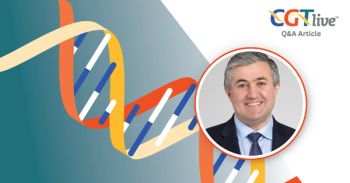
Novel Gene Therapy Shows Potential for Polygenic Conditions
AAV2 TrkB-2A-mBDNF resulted in early signs of efficacy in preclinical studies of glaucoma and humanized tauopathy, which could be translatable to other neurodegenerative polygenic disorders.
The gene therapy AAV2 TrkB-2A-mBDNF effectively transduced both brain-derived neutropenic factor (BDNF) and its receptor tropomyosin receptor kinase B (TrkB) using a single promoter, which resulted in early signs of efficacy in preclinical studies of glaucoma and humanized tauopathy. These findings, which were published in Science Advances, could be broadly translatable to other neurodegenerative and polygenic disorders, the authors suggested.
"The axons of nerve cells function a bit like a railway system, where the cargo is essential components required for the cells to survive and function. In neurodegenerative diseases, this railway system can get damaged or blocked," first author of the study Tasneem Khatib, BM, BCh, from the John van Geest Centre for Brain Repair at the University of Cambridge, said in a statement. "We reckoned that replacing 2 molecules that we know work effectively together would help to repair this transport network more effectively than delivering either one alone, and that is exactly what we found."
For the therapy, AAV2 transduces a self-cleaving 2A peptide containing the coding region for TrkB linked with mature BDNF, which serve as receptor and ligand for each other. In rodent models, intravitreal injection of AAV2 TrkB-2A-mBDNF did not result in retinal ganglion cell (RGC) loss nor impairment of function compared with treatment-naïve RGC. Following transduction, there was a significant increase in BDNF and TrkB expression compared with an AAV2 null control.
The treatment was found to enhance optic nerve anterograde axonal transport, even in uninjured eyes. Transport was measured as 1,407,781 ± 76,284 in an AAV2 null control arm (n = 5), which was similar to eyes that did not receive injections. In the AAV2 TrkB-2A-mBDNF group (n = 5), it was 2,224,777 ± 186,617. Moreover, the study looked at transducing TrkB alone or mBDNF alone and found that combined ligand and receptor replacement was nearly twice as effective, with axonal transport of 2,151,629 ± 191,990 for AAV2 TrkB-2A-mBDNF (n = 5) compared with 1,138,337 ± 13,648 for TrkB by AAV2 alone (n = 4) and 1,327,883 ± 30,372 for mBDNF by AAV2 alone (n = 5).
In rodent glaucoma experiments, intraocular pressure (IOP) was induced using lasers to stimulate normal RGC degeneration and disruption of axonal transport. The treatment by itself was not found to increase IOP compared with an AAV2 null group. However, functional deficits were resolved with AAV2 TrkB-2A-mBDNF compared with a null AAV2 arm.
Axonal transport was improved with the gene therapy compared with null treatment at day 9, 14, and 35 post-injury and treatment but was also statistically significantly improved on day 14 (P <.0001). At this point, the AAV2 null group (n = 4) was 549,638 ±15,124 compared with 1,214,833 ±40,492 for AAV2 TrkB-2A-mBDNF (n = 5). In uninjured eyes (n = 13), it was 1,356,991 ±74,285. Additionally, improvements in anterograde transport to the superior colliculus were seen with the gene therapy compared with AAV2 null treatment at day 9 (P = .39), day 14 (P = .009), and day 35 (P = .02).
The utility of AAV2 TrkB-2A-mBDNF was further explored in the P301S humanized tauopathy model. In this model, transgenic P301S mice showed reductions in anterograde axonal transport at 5 months compare with age-matched mice. Following the onset of Tau pathology, AAV2 TrkB-2A-mBDNF was found to enhance optic nerve axonal transport in 7 mice to 1,454,297 ±70,125 compared with 1,085,928 ±67,416 in naive mice (n = 8). The gene therapy was found to be more effective, when given prior to the onset of Tau pathology (1,863,778 ±27,856 when given early (n = 5).
"While this is currently early-stage research, we believe it shows promise for helping to treat neurodegenerative diseases that have so far proved intractable," study lead Keith Martin, BM, BCh, DM, MRCP, FRCOphth, from the Centre for Eye Research Australia and the University of Melbourne. "Gene therapy has already proved effective for some rare monogenic conditions, and we hope it will be similarly useful for these more complex diseases which are much more common."
Building on these experiments, a similar therapy using an AAV5 vector was also examined in a humanized dementia model of Alzheimer disease. In these early experiments, AAV5 TrkB-2A-mBDNF injection into the perirhinal cortex demonstrated improvements in short-term memory at 8 weeks; however, long-term memory deficits persisted.
"This combined approach also leads to a much more sustained therapeutic effect, which is very important for a treatment aimed at a chronic degenerative disease," said Khatib. "Rather than using the standard gene therapy approach of replacing or repairing damaged genes, we used the technique to supplement these molecules in the brain."
The AAV2 TrkB-2A-mBDNF gene therapy was developed under the name QTA020V by the company Quethera, which was acquired by Astellas in late 2018 to early 2019. In addition to this company, Astellas has also made other gene therapy specific acquisitions, including Audentes Therapeutics.
In March 2021, Astellas announced that it was integrating Audentes into Astellas, as a new division labeled Astellas Gene Therapy. The company noted that genetic regulation is a primary focus of research, which will place further emphasis on therapies like AAV2 TrkB-2A-mBDNF. The 2 leading agents in exploration for Astellas Gene Therapy are for neuromuscular conditions, namely AT132 for X-linked myotubular myopathy and AT845 for Pompe disease.
Newsletter
Stay at the forefront of cutting-edge science with CGT—your direct line to expert insights, breakthrough data, and real-time coverage of the latest advancements in cell and gene therapy.
















































